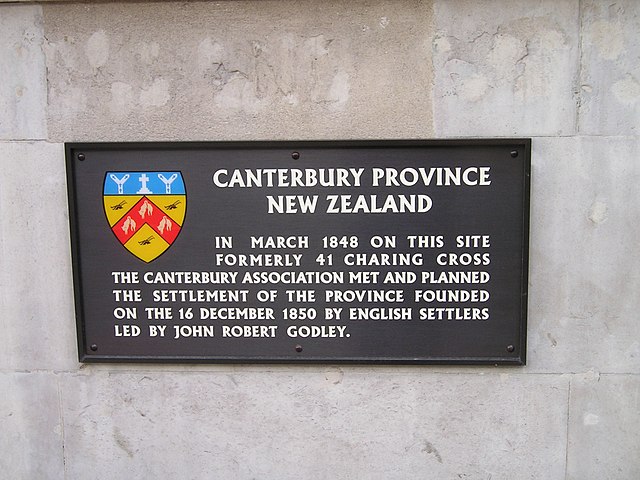Top Qs
Timeline
Chat
Perspective
Canterbury Association
English colonial venture in New Zealand (1848–55) From Wikipedia, the free encyclopedia
Remove ads
The Canterbury Association was formed in 1848 in England by members of parliament, peers, and Anglican church leaders, to establish a colony in New Zealand. The settlement was to be called Canterbury, with its capital to be known as Christchurch. Organised emigration started in 1850 and the colony was established on the South Island. The First Four Ships took out settlers steeped in the region's history. The Association was not a financial success for the founding members and the organisation was wound up in 1855.

Remove ads
Formation of the Association
The Association, founded in London on 27 March 1848, was incorporated by Royal Charter on 13 November 1849. The prime movers were Edward Gibbon Wakefield and John Robert Godley. Wakefield was heavily involved in the New Zealand Company, which had already established four other colonies in New Zealand (Wellington, Nelson, Petre and Otago) by that time. Wakefield approached Godley to help him establish a colony sponsored by the Church of England. John Sumner (the Archbishop of Canterbury) served as the President of the Association's Committee of Management, and the Committee itself included several other bishops and clergy, as well as members of the peerage and Members of Parliament.[1] At its first meeting the Association decided upon names. The settlement was to be called "Canterbury" (presumably after the Archbishop of Canterbury), and the seat of the settlement was "Christchurch" (after the Oxford college Christ Church, at which Godley had studied).
Remove ads
Establishment of the colony
Summarize
Perspective

The Association re-targeted its planned settlement from the Wairarapa to the Banks Peninsula hinterland,[2] where it arranged to buy land from the New Zealand Company for 10 shillings per acre (4,000 m2). The Association then sold the land to its colonists for £3 per acre, reserving the rest, the additional £2 10s, for use in "public objects such as emigration, roads, and Church and school endowments" (20 shillings = £1). The provision of funds for emigration allowed the Association to offer assisted passages to members of the working classes with desirable skills for the new colony. A poster advertising the assisted passages specifically mentions "Gardeners, Shep[herd]s, Farm Servants, Labourers and Country Mechanics". The religious nature of the colony shows in the same poster's requirement that the clergyman of their parish should vouch for applicants, and in the specific earmarking of some of the proceeds from land sales for church endowments.[3]
Godley (with his family) went out to New Zealand in early 1850 to oversee the preparations for the settlement (surveying, roads, accommodation, etc.) already undertaken by a large team of men under the direction of Captain Joseph Thomas. These preparations were advanced, but incomplete when the first ships of settlers arrived on 16 December 1850 – Godley halted them shortly after his arrival in April due to the mounting debts of the Association. Lord Lyttelton, Sir John Simeon, 3rd Baronet, Edward Gibbon Wakefield, and Lord Richard Cavendish guaranteed £15,000 to the Association, which saved it from financial collapse.[4]
In 1852, the Parliament of the United Kingdom passed the New Zealand Constitution Act 1852, which amongst other things established provincial councils. The Constitution contained specific provisions for the Canterbury Association; the first being that the new General Assembly (New Zealand Parliament) could not amend the legislation establishing the Canterbury Association,[5] the second being that the Canterbury Association could hand its powers to a newly established provincial government (the Canterbury Province).[6]
As a result, affairs of the Canterbury Association were wound up in 1855 and outstanding settlement lands were handed over to the Canterbury Province.[7]
Remove ads
Ships
Summarize
Perspective

Charlotte Jane and Randolph arrived in Lyttelton Harbour on 16 December 1850, Sir George Seymour the following day, and Cressy on 27 December, having set sail from England in September 1850. The British press dubbed the settlers on these first four ships "Canterbury Pilgrims." A further 24 shiploads of Canterbury Association settlers, making a total of approximately 3,500, arrived over the next two-and-a-half years.[1]
Sources vary about the exact number of emigrant ships that the Canterbury Association sent to New Zealand. Some ships stopped at intermediate ports, either for repairs or because they had passengers for those ports. Ports such as Nelson or Wellington were also Ports of Entry, so immigrants might be recorded as arriving at that port before trans-shipping to Lyttelton (known as Port Victoria) and Canterbury. Shipping intelligence reported in the local newspapers of the time reported the ship's arrival but did not usually identify the commissioning organisation, only the port of origin or intended destination, the ship's master or captain, tonnage, and the date of arrival or departure. Cargo might also be reported. This means the ships on a particular list may depend on the inclusion criteria. Overall, these 28 ships listed below appear to be emigrant ships of the Canterbury Association. (In order of arrival.)[1][8]
Remove ads
See also
References
Further reading
External links
Wikiwand - on
Seamless Wikipedia browsing. On steroids.
Remove ads
